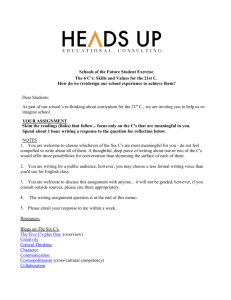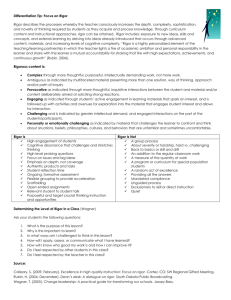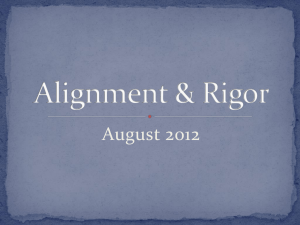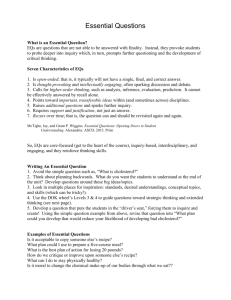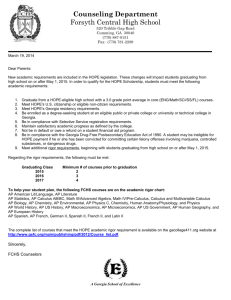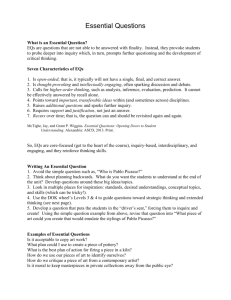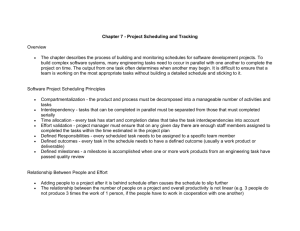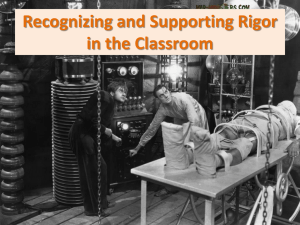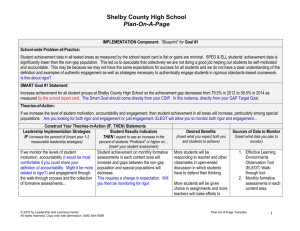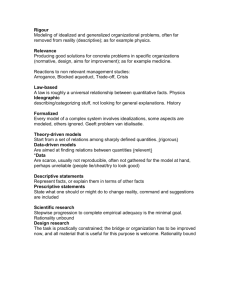Rigor
advertisement
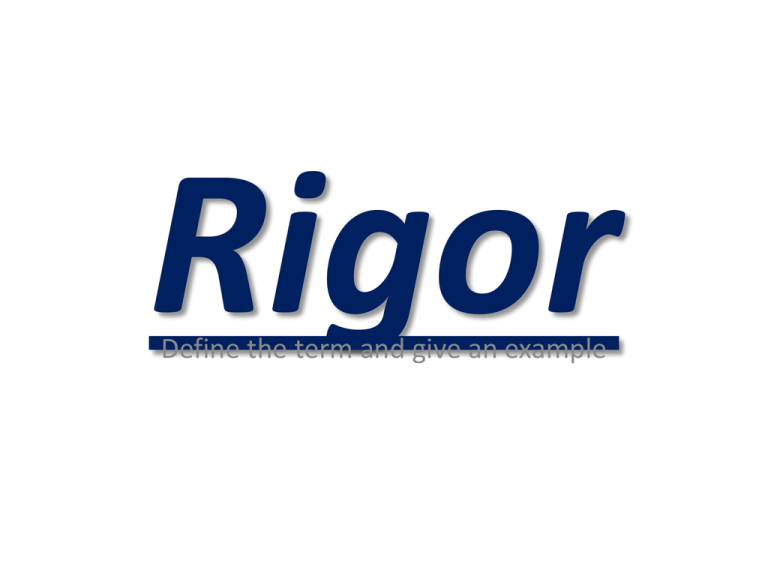
Rigor Define the term and give an example 1. Defining Rigor Rigor is creating an environment in which each student is expected to learn at high levels, • each student is supported so he or she can learn at high levels, • and each student demonstrates learning at high levels. (Blackburn, 2008) • True rigor is the result of weaving together all elements of schooling to raise students to higher levels of learning. Blackburn, 2012 Creating an environment in which each student is expected to learn at high levels, each student is supported so he or she can learn at high levels, and each student demonstrates learning at high level. What is happening in the average classroom? Behaviors Percentage Evidence of clear learning goals/objectives 4% Worksheets 52% Lecture 31% Monitoring with no feedback 22% Use of high yield research based instructional strategies 2% Communication rich environments with writing and rubrics 2% Fewer than half the students engaged 82% Bell to bell learning Less than 1% Learning 24/7 Classroom Observation Project, 2004, Direct Observation of 1,500 K-12 Classrooms Management Attribute Managing Examples PLANNING ATTRIBUTE Planning EXAMPLES Rigorous Design ‐ example http://www.slideserve.com/palma/writing‐lessons‐for‐rigorous‐and‐relevant‐instruction RBT - Revised Bloom’s Taxonomy Creating Designing, constructing, planning, producing, inventing, Checking, critiquing, judging, experimenting, detecting, monitoring Comparing, organizing, deconstruction, outlining, integrating Implementing, using, solving, performing U Interpreting, summarizing, classifying, comparing, explaining, defining R Recognizing, listing, describing, retrieving, locating, labeling, RBT and Learning Levels Bloom’s Level Creating Thinking/Doing Verbs Designing, constructing, planning, producing, inventing, Evaluating Checking, critiquing, judging, experimenting, detecting, monitoring Analyzing Comparing, organizing, deconstruction, outlining, integrating Applying Implementing, using, solving, performing Understanding Remembering Interpreting, summarizing, classifying, comparing, explaining, defining Recognizing, listing, describing, retrieving, locating, labeling, Level of Learning (most associated) Level 3 Level 2 Webb’s Depth of Knowledge http://epsf7450‐fall2010.wikispaces.com/file/view/Curriculum+Presentation.ppt Rigor ‐ Literacy Standards and DOK Levels APPLYING, ANALYZING & EVALUATING From Lining Up: The Relationship between the Common Core State Standards and Five Sets of Comparison Standards by David T. Conley Kathryn V. Drummond Alicia de Gonzalez Mary Seburn Odile Stout Jennifer Rooseboom 2011 Educational Policy Improvement Center 5E Instructional Model Johann Friedrich Herbart (1776‐1841) German philosopher, psychologist, and educator Engage - Explore - Explain - Extend - Evaluate According to Herbart, the best pedagogy allows students to discover relationships among their experiences. Elements of direct instruction are used where the teacher systematically explains ideas that the student could not be expected to discover. Finally, the teacher provides opportunities for students to demonstrate their understanding. Connecting the Dots 1. 2. Engage ‐ peak student interest/get personal involvement in the lesson Explore - provide learning structure for students to find relationships and solutions for themselves 3. Explain - guide students to take what they have learned and figure out what it means 4. Extend ‐ allow students to use their new knowledge and continue to explore its implications 5. Evaluate ‐ determine the level of learning and understanding has taken place 1. 2. 3. 4. 5. 6. 7. 8. 9. Gain attention Create expectancy Provide recall of prior learning Present the stimulus Provide learning guidance Elicit performance Provide feedback Informally assess Enhance retention and transfer 1. 2. Objectives Standards (expectations) 3. 4. 5. 6. 7. 8. Anticipatory set (hook) Teaching Guided practice Closure Independent practice Assess Steps to Follow to establish RIGOR 1. Create the environment- Objectives, game plan, Questioning that embedded in instruction 2. Ask open-ended questions, ones that are at the higher levels of Blooms Taxonomy (analysis, synthesis) 3. High levels questions = high level answers (push students to respond at high levels) Probe and guide the student in the right direction 4. Mastery through student engagement (Activities) + (Assessment) Split-note taking, pair-share, acti-votes, parking lots, Sticky paper, Small whiteboards, hand signals, jig-saw Inquiry Project Based Learning Authentic Engagement Mental Models Questioning Evidence Ensuring Students Demonstrate Learning at High Levels • Mastery through student engagement (Activities) + (Assessment) Split-note taking, pair-share, acti-votes, parking lots, Sticky paper, Small whiteboards, hand signals, jig-saw Differentiation and Rigor in Action…Content z Reading Partners/ Reading Buddies z Read/Summarize z Visual Organizer/Summarizer z Choral Reading z Note Taking Organizers z Guided Notes z Books on tape/iPod Raising Rigor In Your Classroom! zHow can you increase rigor in your classroom? z What do you need support with in the area of Planning and management?
